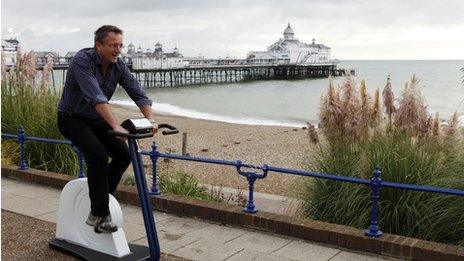Can three minutes of exercise a week help make you fit?
- Published
- comments

A few relatively short bursts of intense exercise, amounting to only a few minutes a week, can deliver many of the health and fitness benefits of hours of conventional exercise, according to new research, says Dr Michael Mosley. But how much benefit you get from either may well depend on your genes.
When I first read studies which suggested that I could make significant and measurable changes to my fitness by doing just three minutes of exercise a week, I was incredulous.
But this apparently outrageous claim is supported by many years of research done in a number of different countries including the UK, external, so I decided to give it a go.
My guide into the world of High Intensity Training (HIT), was Jamie Timmons, professor of ageing biology at Birmingham University.
Jamie assured me that by doing just three minutes of HIT a week for four weeks, I could expect to see significant changes in a number of important health indices.
The first, and the one I was most interested in, is insulin sensitivity. Insulin removes sugar from the blood, it controls fat and when it becomes ineffective you become diabetic.
My father was a diabetic and died from complications of that disease. Jamie assured me that research from a number of centres has shown that three minutes of HIT a week improves insulin sensitivity by an average of 24%.
The second improvement I was likely to see would be in my aerobic fitness. Aerobic fitness is a measure of how good your heart and lungs are at getting oxygen into your body and is an excellent predictor of future health. I asked Jamie why.
"The simple answer is we don't know," he replied. "What we do know is that it is a very, very powerful predictor of future health."
Genetic test
So if I could improve my insulin sensitivity and my aerobic fitness then that should improve my general health. But Jamie said there was a potential sting in the tail. There was a possibility that I wouldn't improve. Not because HIT doesn't work but because I've inherited the wrong genes.
The fact is that people respond to exercise in very different ways. In one international study, external 1,000 people were asked to exercise four hours a week for 20 weeks. Their aerobic fitness was measured before and after starting this regime and the results were striking.
Although 15% of people made huge strides (so-called "super-responders"), 20% showed no real improvement at all ("non-responders").
There is no suggestion that the non-responders weren't exercising properly, it was simply that the exercise they were doing was not making them any aerobically fitter.
Jamie and his collaborators investigated the reasons for these variations and discovered that much of the difference could be traced to a small number of genes, external.
On the basis of this finding they have developed a genetic test to predict who is likely to be a responder, and who is not. Jamie offered me that test. But I would not be told the results until I had completed my HIT regime.
I agreed, had blood taken and went through some baseline tests to assess my starting point, fitness-wise. Then I began to do HIT.
Full throttle
It's actually very simple. You get on an exercise bike, warm up by doing gentle cycling for a couple of minutes, then go flat out for 20 seconds.
A couple of minutes to catch your breath, then another 20 seconds at full throttle. Another couple of minutes gentle cycling, then a final 20 seconds going hell for leather. And that's it.
Horizon presenter on treadmill
So how does it work? According to Jamie, and other researchers I spoke to, part of the explanation is (probably) that HIT uses far more of our muscle tissue than classic aerobic exercise.
When you do HIT, you are using not just the leg muscles, but also the upper body including arms and shoulders, so that 80% of the body's muscle cells are activated, compared to 20-40% for walking or moderate intensity jogging or cycling.
Active exercise also seems to be needed to break down the body's stores of glucose, deposited in your muscles as a substance called glycogen. Smash up these glycogen stores and you create room for more glucose to be sucked out of the blood and stored.
Somewhat sceptical I went off and dutifully did my four weeks of HIT, making a grand total of 12 minutes of intense exercise and 36 minutes of gentle pedalling. I then went back to the lab to be retested.
The results were mixed. My insulin sensitivity had improved by a remarkable 24%, which was extremely satisfying, but my aerobic fitness had not improved at all.
I was crestfallen, but Jamie was not surprised. It turns out that the genetic test they had done on me had suggested I was a non-responder and however much exercise I had done, and of whatever form, my aerobic fitness would not have improved. My dreams of winning Olympic gold ended there and then.
I will continue doing HIT because I can see the benefits. It won't suit everyone, because although it is short, it is extremely intense. Like any new exercise regime if you have a pre-existing medical condition you should consult your doctor before trying it.
Michael Mosley presents Horizon: The Truth About Exercise is on BBC Two at 21:00 GMT on Tuesday 28 February 2012 or watch online afterwards at the above link.